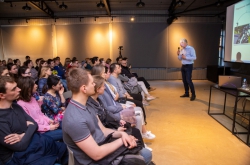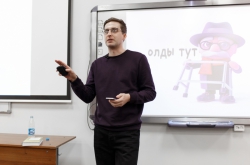“Everyone talks about Big Data, though few understand what it is” - Yuri Volkov, Science Slam’s participant and student for ITMO University’s Department of Computational Technologies.
Defining Data Science - the science about data - is no easy task. This is a data-based science that researches the ways to derive useful knowledge from this data. Yet, this definition has to include yet another term - statistics. If one reads statistics definition on wikipedia, it will be just paraphrasing that of Data Science. So, what's the point? Someone just wanted to give a new definition to an existing term?
In reality, Data Science and statistics are both terms that many people misuse. Whenever some new popular term emerges, many start using it just everywhere. For instance, I’ve been noticing that the term Data Science is now included in the name of different conferences - and I still have to check whether the conference will be on this topic or the term is just used for drawing attention.
To find out where does all this confusion come from, one has to look deeper. The term was first mentioned in the 1970s, when computer performance started to grow and it has become necessary to combine the new computational capacities with statistics. Around the late 90’s, an article was published where the author stated that Data Science and statistics are the same thing. Yet, in 2012 the renowned statistician Nathaniel Silver who predicted the presidential election results that year called Data Science an offence to statistics.

Yet, specialists in Data Science need statistics. What’s more, they should also be well-versed in programming and the field they study. If a person who's applying for a position that has to do with Data Science doesn’t know what Bayes' theorem is, or isn’t good at programming, there’s just no point in focusing on this field.
To understand what Data Science is, one needs to know about machine learning. It is a field in computer science that studies the methods to developing algorithms that have the ability to learn, i.e. improve themselves. For instance, by knowing your age, sex, and revenue, a programmist can always write an algorithm that will predict what drinks you’ll order in a bar. Through machine learning, it is possible to make predictions, calculate probabilities, arrange documents and the like.
For instance, one has to predict the popularity of an emoticon that looks like a cat in a particular social network for a particular time span. How can this be done? First, it is necessary to study the data we already have, i.e. data on the emoticon’s popularity for the previous period. Then, we calculate a function that makes use of this data, and develop a corresponding algorithm. In a sense, machine learning is about adjusting the data you already have.
 Yuri Volkov
Yuri Volkov
Who is interested in Data Science? First of all, banks. No bank would ever give anyone a credit without analyzing whether they’ll be able to return it or not. To do that, specialists analyze data about their employment record, marital status, age and other things. Data Science can also be used for various other purposes, predicting films’ rankings, for instance. I’ve conducted such an analysis and learned many interesting facts, for example, that fewer people will watch a film if there are many people on its poster. Strange? Yet true. I’ve checked my algorithm on the Rogue One: A Star Wars Story movie and predicted that it will get 8.18 in the rankings; it got 7.9. By using such algorithms, the producers can predict whether a movie that meets particular parameters will be popular or not (you can read about such algorithms in more detail here -- Ed.). Also, I tried using algorithms to predict my marks for an upcoming lab session based on my previous results. Thus, I’ve learned that I don’t have to repeat the materials from my second lab session, but cram those of the third. Surely, for different fields, Data Science algorithms of different complexity are used, as in some, medicine, for instance, the price of a mistake is very high.
“Memes are to be perceived as folklore,” - Alexandra Rusakovich, language expert from St. Petersburg State University.
Memes are quite a complex field of research, partly because Richard Dawkins who’s introduced the term to the masses confused everyone a little. The defined memes are units of cultural transmission that can mutate and form groups and are subject to natural selection processes. His memetics never got the status of an actual science; and Internet memes are different from what Dawkins worked with. Memes in the Internet space are information objects that can spontaneously win popularity.

Memes are easily recognized by their properties: they are fun, relevant, viral and in most cases absurd. Yet, these are only the minimal set of the essential characteristics. In reality, giving memes a strict definition seems impossible, similar to how it is impossible to strictly classify different genres of poetry. In most cases, you just know that something is a meme as soon as you see it. Also, memes have their lifespans. One first uses them, “invents them, so to say, then it is picked up by others, it reaches its peak and gradually “dies” - though some memes even become part of the language.
What forms can memes take? They can be words, icons, songs, posts or even whole Internet articles. In memes, you’ll most definitely find wordplay, deliberate mistakes and slang. So, why Internet users are so fond of silly words or breaking the rules of grammar? According to theory, Internet communication has much in common with Medieval carnival culture. Virtual communication creates a virtual personality that act according to the rules of the game. Such virtual personalities don’t use the communication for work, rather to rest and have fun by using different methods. The virtual personality generally stays within the network, but becomes really creative.
 Alexandra Rusakovich
Alexandra Rusakovich
Meme words like LOL are very easy to remember, as according to neurophysiologists, everything that we perceive as flashy, stupid or irritating triggers emotions, and emotions help us remember. This way, the adults remember stupid words easier, as for them they are even more stupid than for school students.
The most interesting thing about memes from a language experts’ point of view is the emergence of new languages. For instance, why do animals in memes speak in a language that really differs from the one we are used to? It turns out that it has to do with how we ourselves converse with animals. When talking to children, we are trying to pronounce the words very distinctly to help them to learn the language faster. As for animals who can’t talk, we just use unfinished sentences or abrupt words, so, in our imagination, they would’ve answered us in the same way, much like people who’ve forfeited learning a language and only use the simplest grammar forms.
What are the different kinds of memes? Narrative memes are very popular. They can be images, words, some context which is incomplete and to be finalized by the user. A popular example in Russia would be the popular meme with a person standing in a swamp; one can add various explanations to the picture, like “When I start cramming for exams” or “when I start to clean up” - such memes always imply having some written message.
A strange type of meme is a meme based on copying the style of some Internet article. For instance, the memes based on Pavel Durov’s post “Seven things I quit many years ago...” - many users began making similar lists using the same grammar and the like. Such memes show that Internet communication is becoming all the more complex.

Another unusual type of meme is complex stunts - memes that can be understood only by some narrow audience, philologists, for instance. Those are usually present in specialized pages. By the way, such memes begot the simple meme - the phrase “Too complex. Goodbye”.
As of now, we can also observe such a phenomenon as meme-based communication. Have you ever noticed that Internet discussion often starts as normal correspondence but ends with posting some gif? There are even people who take pride in being able to communicate by using memes only. And that is art. Much like with the foreign languages: there is a set of words that you have to know to be able to converse in any situation. The same can be applied to memes: if you know some thousand and a half memes, you can use them and them only to communicate via the Internet. This is why I believe that memes are to be perceived as folklore.





